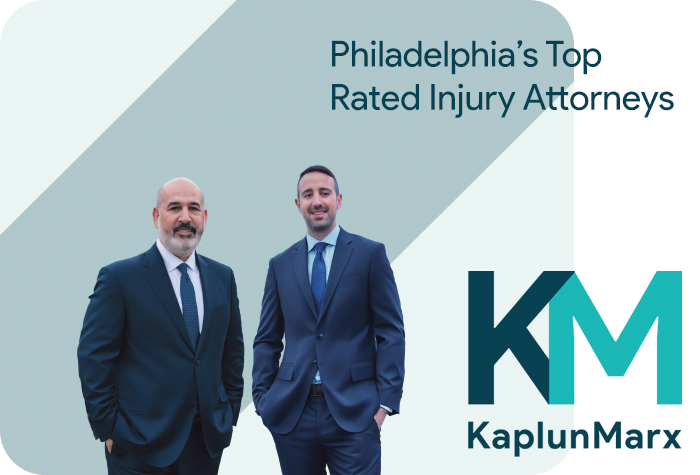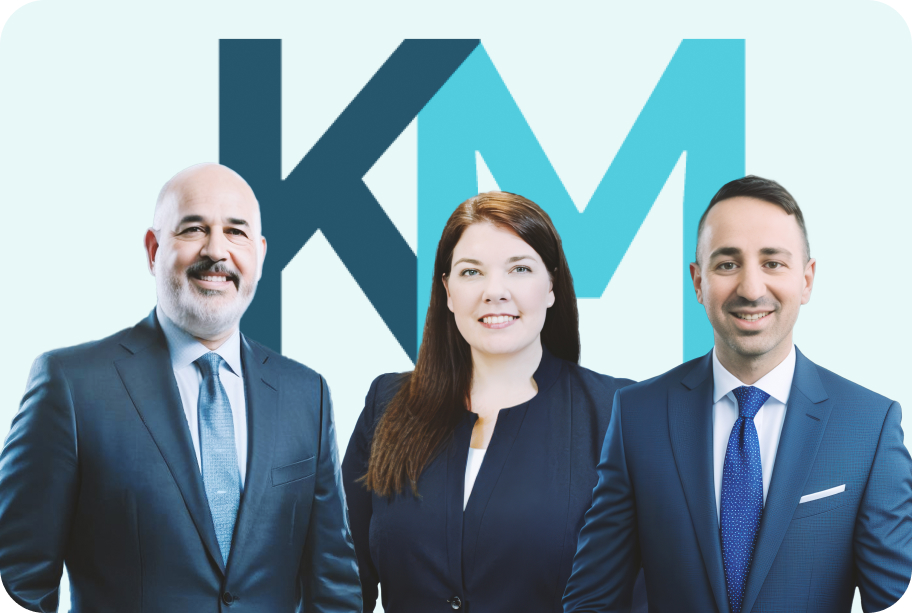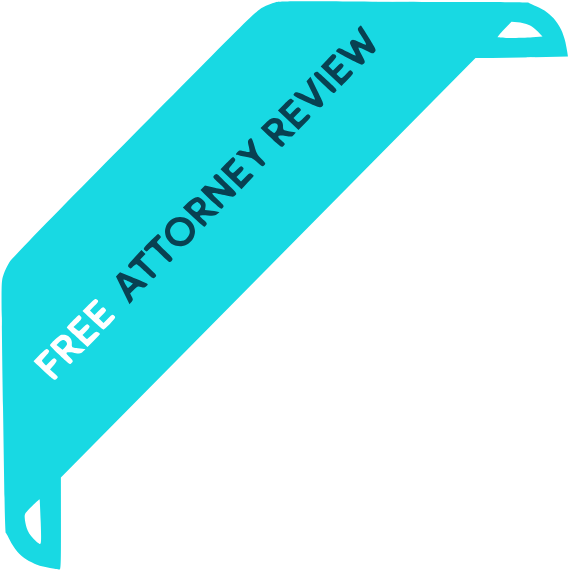
WE’RE NOT JUST ANOTHER PERSONAL INJURY ATTORNEY TEAM.
Get started with zero cost until you win. We’ve been shown to be the top responsive and personal, yet aggressive full service no-fee-until-you-win injury firms in Philly according to actual client reviews.


WHEN YOU’VE BEEN HURT DUE TO SOMEONE ELSE’S NEGLEGENCE, TIME CAN WORK AGAINST YOU IF YOU’RE NOT PROTECTED BY AN ATTORNEY. AT KAPLUNMARX PHILLY, ONE OF OUR ACCIDENT ATTORNEYS CAN GET STARTED ON YOUR REVIEW RIGHT AWAY – OFTEN THE VERY SAME DAY.


WHY CHOOSE US

We are trial attorneys in Philadelphia, and we have an excellent record of getting successful resolutions for our client's cases.

We are proud of the results we have gotten, which have been in the millions of dollars for our Philadelphia personal injury clients.

Our Philadelphia lawyers proudly serve English, Spanish, and Russian communities.
You'll work with a lawyer who only focuses on injury claims and lawsuits for injury victims so you'll have specific experience on your side.
Unlike the big firms that churn as much volume as possible, we are not a settlement mill. We won't back down even if it means taking them to court.
We never just turn you over to a case worker and bar your access to your attorney. You'll speak directly to your attorney and have access when needed throughout the case.
We are actually from Philly and physically work here. We spend our time and money focusing on local clients, not buying billboards and TV ads in other areas.




MORE THAN JUST CLAIMS AND CASES


TESTIMONIALS
At KaplunMarx, you will experience outstanding client service. You will work directly with one of our top attorneys, who will aggressively pursue your injury case to achieve an outstanding result and get maximum money for your accident case.







ATTORNEYS

ATTORNEY

ATTORNEY

ATTORNEY

WE TAKE CARE OF EVERYTHING

We charge you nothing to evaluate your claim. Since we work on a contingency basis with no upfront cost you, we can’t take every case. But if we do take it, we’ll get started on it immediately. If we don’t we will give you options.
We help get you set up with medical treatments and evaluations from healthcare professionals. If you don’t have insurance, we can help get you treatment anyway. Documenting injuries and treatments is crucial for establishing damages and proving the extent of harm suffered.
We leave no stone unturned. We do comprehensive evidence gathering, including physical evidence, witness statements, and official reports. We also do accident analysis, often utilizing expert consultations and accident reconstruction techniques, as well as thorough documentation of damages and determination of liability. This critical phase lays the foundation for the case, typically lasting several weeks to months depending on the complexity, and aims to build a strong claim for negotiations or potential litigation.
Once you reach maximum medical improvement, your KaplunMarx assigned attorney compiles a demand package. This includes a demand letter outlining the incident, injuries, medical treatments, and the compensation sought for damages.
Your attorney sends the demand package to the opposing party or insurance company. Negotiations begin to reach a fair settlement without proceeding to court.
If negotiations fail to yield a satisfactory settlement, the attorney files a formal lawsuit in the appropriate court, officially initiating legal proceedings.
We exchange information with the other side through processes like depositions, interrogatories, and requests for documents. This phase allows each side to gather evidence and understand the other’s claims and defenses.
Before trial, parties may attempt to resolve the case through mediation or arbitration. A neutral third party assists in facilitating a settlement to avoid the costs and uncertainties of trial.
If the case isn’t settled, it proceeds to trial where both sides present evidence and arguments. A judge or jury examines the facts to determine liability and award damages.
Once a settlement is reached or judgment awarded, the attorney assists in collecting the compensation, which may involve dealing with insurance companies or setting up payment plans. After all compensation is received and legal matters concluded, your attorney closes the case, providing the client with final documents and ensuring all obligations are fulfilled.

COMPLETE PERSONAL INJURY HELP WITH DECADES OF EXPERIENCE
Whether it’s a slip and fall at a Philadelphia big box store or a more severe incident like a car accident involving broken bones, we are here to help you through it.
KaplunMarx is different because we treat every case with the care and concern we would if you were our own family, because when we represent you, you are family.
Your case is never just a number like at the big billboard firms. As a truly local firm, we have the resources and connections to get you the help you really need – both medically and legally.
We work with clients of every personal injury claims type from soft tissue to serious injuries.
Personal injury attorney representation is a specialized legal service provided by attorneys who advocate for individuals who have suffered harm due to the negligence or wrongdoing of others. The primary goal of this representation is to secure compensation for the injured party, covering medical expenses, lost wages, and pain and suffering. Personal injury lawyers possess a deep understanding of tort law, which encompasses civil wrongs and economic or non-economic damages to a person’s property, reputation, or rights.
These legal professionals guide their clients through the complex legal system, offering counsel on the viability of claims, the potential for settlement, and the advisability of proceeding to trial. They perform a crucial role in negotiating with insurance companies and opposing parties to reach a fair settlement. When necessary, they are prepared to take a case to court to ensure their clients receive just compensation.
Personal injury attorney representation encompasses a wide range of incidents, including but not limited to automobile accidents, slip and fall accidents, medical malpractice, and workplace injuries. The representation begins with a thorough investigation of the incident to gather evidence, followed by the formulation of a legal strategy tailored to the specifics of the case. Understanding the search intent, individuals seeking personal injury attorney representation are often looking for expertise and support during a challenging time.
They require a professional who can navigate legal complexities, advocate on their behalf, and ultimately secure a favorable outcome. This representation not only addresses the immediate financial burdens of an injury but also contributes to the broader objective of holding negligent parties accountable for their actions, promoting a sense of justice and deterrence against future misconduct.
Individuals may require the services of a personal injury attorney when they have suffered harm due to another’s negligence or intentional act. This need typically arises in situations where the complexity of legal proceedings, the expertise required to negotiate with insurance companies, and the pursuit of fair compensation exceed the capabilities of non-specialists. The expertise of a personal injury lawyer is invaluable in navigating the intricacies of tort law, ensuring that the victim’s rights are protected, and advocating for the maximum compensation possible.
Whether the case involves an automobile accident, a slip and fall incident, medical malpractice, or a workplace injury, a personal injury attorney provides the necessary legal representation to address both the immediate and long-term repercussions of the injury. By securing a personal injury attorney, individuals not only enhance their chances of receiving appropriate compensation but also ensure that the responsible parties are held accountable, thereby contributing to the broader goals of justice and deterrence.
Selecting the right personal injury attorney involves evaluating factors that ensure the lawyer is well-suited to represent the client’s specific needs. Key considerations include the attorney’s client-centric approach, which prioritizes the client’s well-being and objectives. The attorney’s track record as a million-dollar strategist indicates experience in securing high-value settlements or verdicts, which is essential for clients seeking substantial compensation.
Availability is another critical factor; 24/7 legal warriors offer round-the-clock support, ensuring clients have access to legal assistance whenever necessary. Experience and specialization in personal injury law, particularly in areas relevant to the client’s case such as car accidents or medical malpractice, are fundamental. The attorney’s years of practice and focus on specific types of personal injury claims provide insight into their capability to handle complex cases.
Client reviews and case outcomes, including positive testimonials on legal directories, offer tangible evidence of the attorney’s success and client satisfaction. The communication and comfort level between the attorney and the client is paramount for a successful partnership. An attorney who provides clear and regular updates on case progress and demonstrates empathy and understanding of the client’s situation fosters trust and eases the stress of the legal process.
To enhance the usefulness of this section, consider the following additions:
The process of working with a personal injury attorney involves several key steps designed to build a strong case and achieve a favorable outcome. Initially, it begins with an initial consultation, where the client and attorney discuss the accident and injury details, providing an opportunity to understand legal options and potential outcomes. Following this, an investigation and evidence gathering phase occurs, involving collecting police reports, medical records, and interviewing witnesses to build a comprehensive case.
The next step is filing a lawsuit, where the attorney drafts and files complaint documents and serves the defendant, officially starting the legal process. Negotiation and settlement efforts typically precede a trial, with the attorney presenting evidence to the defendant’s insurer in hopes of reaching a satisfactory settlement. If negotiation does not result in a fair settlement, the case may proceed to trial, involving jury selection and presenting the case in court.
Throughout these steps, the attorney provides clear and regular updates on case progress, ensuring the client is well-informed and involved in the decision-making process. This structured approach aims to secure the best possible outcome, whether through settlement or court verdict, compensating for medical bills, lost wages, and pain and suffering.
The journey begins with an initial consultation, a pivotal step where the attorney assesses the accident and injury details, laying the foundation for the legal strategy. Typically, this consultation is free and lasts about an hour, during which the attorney will evaluate the strength of your case and discuss the next steps.
During this phase, there’s a detailed discussion of the accident and injury details, ensuring the attorney fully comprehends the incident’s context and the extent of the client’s injuries. This conversation helps the attorney to understand the nuances of your case, including any potential challenges.
Clients are informed about their legal options and potential outcomes, equipping them with knowledge on the various paths their case could follow. The attorney will outline possible scenarios, from settlement negotiations to trial, and what each might entail in terms of time and potential compensation.
A thorough investigation and evidence gathering phase follows, meticulously compiling every detail relevant to the case to construct a compelling argument. This step can take several weeks to months, depending on the complexity of the case and the availability of evidence.
Essential to the case are police reports and medical records, which provide official accounts of the incident and document the injuries sustained. Obtaining these documents can be time-consuming but is crucial for substantiating your claim.
Interviewing witnesses adds valuable perspectives to the accident, offering testimony that can significantly bolster the case. This process varies in length, depending on the number of witnesses and their availability.
The formal legal process begins with filing a lawsuit, where complaint documents are drafted and filed, outlining the damages sought and the justification behind them. The timeline for this step can vary, but it generally occurs within a few months after deciding to proceed with legal action.
The drafting and filing of complaint documents establishes the legal foundation for the claim, detailing the sought-after damages and their rationale. This is a critical step that requires meticulous attention to legal detail and can take several weeks to complete.
Serving the defendant with the lawsuit notifies them of the legal action, compelling them to respond to the allegations made. The defendant typically has a set period, usually about 20 to 30 days, to respond.
The negotiation and settlement phase aims for a resolution agreeable to both parties, often involving strategic discussions and the presentation of evidence to the defendant’s insurer. Negotiations can last from a few months to over a year, depending on the willingness of both parties to compromise.
Presenting evidence to the defendant’s insurer is a strategic effort to showcase the case’s strength, prompting a fair settlement offer. This step is crucial for negotiations and can significantly influence the settlement amount.
Mediation sessions offer a venue for both parties to articulate their positions with a neutral mediator, striving for a mutually satisfactory resolution. Mediation can be a quicker alternative to trial, often resolved in a few days to weeks.
Should negotiations falter, the case advances to trial, where arguments are presented in court before a judge or jury. A trial can last from days to several weeks, depending on the complexity of the case and court schedules.
Jury selection involves selecting impartial individuals to hear the case and render a verdict based on the evidence and arguments presented. This process typically takes a few days.
Presenting the case in court is the culmination of all preparatory efforts, where the attorney argues on behalf of the client, aiming to secure a favorable verdict. The duration of this step varies widely, depending on the case’s intricacies and the court’s schedule. By detailing the typical duration of each step, common challenges, and how an attorney can assist, this section now offers more practical guidance for individuals navigating the process of working with a personal injury attorney in Philadelphia.
Hiring a personal injury attorney can lead to several potential outcomes, each significantly impacting the client’s recovery and pursuit of justice. A settlement outside of court is a common resolution, where the attorney negotiates a lump-sum payment or structured settlement with the defendant or their insurer. This route is often pursued for its efficiency and the ability to provide swift financial relief to the injured party, avoiding the uncertainties of a trial.
Alternatively, the case may proceed to trial, potentially resulting in a court verdict in favor of the client. This outcome can lead to compensation covering medical bills, lost wages, and pain and suffering, acknowledging the full extent of the client’s losses and suffering. However, there is also the possibility of a court verdict against the client, where no compensation is awarded.
This underscores the inherent uncertainties within the legal process but highlights the importance of having skilled legal representation. Regardless of the outcome, the decision to hire a personal injury attorney is a strategic move towards securing legal representation equipped to navigate the complexities of personal injury claims, advocate for the client’s best interests, and strive for the most favorable resolution possible. To enhance this section’s relevance and helpfulness, incorporating statistical data or case examples could provide readers with a clearer understanding of what to expect.
For instance:
Outcome Type | Description | Example/Statistical Data |
Settlement Outside of Court | Agreement reached without going to trial. | 95% of personal injury cases are settled pre-trial. |
Lump-Sum Payments | One-time payment to settle the claim. | Average lump-sum settlement in Philadelphia: $25,000. |
Structured Settlements | Payments made over a period to provide long-term financial support. | Example: $100,000 paid over 10 years. |
Court Verdict in Favor | Client wins the case at trial. | Average compensation for verdicts in favor: $60,000. |
Compensation for Specific Damages | Covers medical bills, lost wages, pain and suffering. | Example: Medical bills: $30,000, Lost wages: $20,000. |
Court Verdict Against | Client loses the case at trial, no compensation awarded. | Statistically rare, with specific data varying by case. |
Potential for Appeal | Opportunity to challenge an unfavorable decision. | Appeals success rate: Approximately 20%. |
Including such data not only provides a quantitative perspective on potential outcomes but also sets realistic expectations for individuals considering hiring a personal injury attorney in Philadelphia.
The financial commitment of hiring a personal injury attorney in Philadelphia primarily revolves around contingency fees, where the attorney’s payment is a percentage of the settlement or verdict award. This arrangement aligns the attorney’s incentives with the client’s success, enabling individuals to pursue legal action without upfront costs. Attorneys only receive payment if they win the case, making legal representation accessible to those who might not afford it otherwise.
However, some cases might involve hourly rates, though this is rare and typically reserved for consultation services. Beyond attorney fees, clients should be aware of expenses and costs associated with their case, such as court fees and expert witness fees. These expenses are necessary for the thorough preparation and execution of the case.
While some attorneys might advance these costs, they are ultimately the client’s responsibility, typically reimbursed from the awarded compensation.
Below is a detailed breakdown of the costs associated with hiring a personal injury attorney in Philadelphia, presented in a markdown table format for clarity:
Cost Type | Description | Typical Range/Amount |
Contingency Fees | Payment to the attorney as a percentage of the settlement or verdict award. | 25% – 40% of the settlement/award |
Hourly Rates | Fees charged for consultation services, rare in personal injury cases. | $100 – $400 per hour |
Court Fees | Fees required for filing a lawsuit and other court proceedings. | $150 – $300 |
Expert Witness Fees | Costs associated with hiring experts to testify or consult on the case. | $200 – $500 per hour |
Investigation Costs | Expenses for gathering evidence, including private investigators. | $50 – $100 per hour |
Medical Records | Fees for obtaining comprehensive medical records relevant to the case. | $20 – $100 per request |
Postage/Shipping | Costs for mailing and shipping documents related to the case. | $10 – $50 |
Copy Costs | Expenses for copying documents and evidence for the case. | $0.10 – $0.50 per page |
Trial Exhibits | Costs for preparing visual aids and exhibits for trial. | $200 – $2,000+ depending on complexity |
In Pennsylvania, the statute of limitations sets a 2-year deadline from the date of injury for filing a personal injury claim. This legal timeframe is crucial as it dictates the window within which an injured party can seek compensation through the court system. Failing to file within this period generally results in the loss of the right to litigate the matter, effectively barring the injured party from pursuing compensation for their damages.
It’s essential for individuals considering legal action to be aware of this deadline to ensure their claim is filed timely, preserving their opportunity for legal recourse and justice. Understanding the exceptions to this rule, such as the discovery rule, and the consequences of missing the filing deadline is critical. An attorney can provide invaluable assistance in navigating these deadlines and ensuring that your claim is filed within the appropriate timeframe.
Pennsylvania’s statute of limitations mandates that personal injury claims must be filed within 2 years from the date of injury. This legal boundary is essential, as it ensures that individuals seeking compensation for their injuries initiate their legal action within this specified timeframe, thus safeguarding their right to pursue justice and financial recovery.
The following table provides detailed information on the exceptions to the general 2-year statute of limitations for personal injury claims in Pennsylvania, including examples of when the discovery rule has been applied and other notable exceptions:
Exception Type | Description | Example Cases or Situations |
Discovery Rule | The clock starts when the injury is discovered, or reasonably should have been discovered. | Cases involving medical malpractice where the harm becomes apparent only after some time. |
Minor Plaintiffs | The statute of limitations does not begin until a minor reaches the age of 18. | A child injured in an accident has until their 20th birthday to file a personal injury claim. |
Mental Incapacity | If the injured party is mentally incapacitated, the statute may be tolled until capacity is regained. | An individual who suffers a traumatic brain injury may have the statute tolled during incapacity. |
Fraudulent Concealment | If the defendant has taken steps to prevent the discovery of the injury. | A situation where the defendant hides evidence or misleads the plaintiff about the cause of injury. |
Failing to file a personal injury claim within the statute of limitations typically results in the claim being barred, meaning the injured party loses the legal right to seek compensation for their injuries through the court system. This underscores the importance of consulting with an attorney early to ensure compliance with all relevant deadlines.
An experienced personal injury attorney can help navigate the complexities of the statute of limitations, including identifying any applicable exceptions and ensuring that your claim is filed in a timely manner. They can also provide advice on the strategic implications of filing deadlines and how best to proceed with your claim.
Pennsylvania law encompasses specific regulations that govern personal injury claims, including the comparative negligence rule which allows for partial compensation if the plaintiff is less than 51% at fault for the incident that caused their injuries. This nuanced approach to determining liability ensures that even if injured parties are partially responsible, they can still recover a portion of the damages, proportionate to their degree of fault. Additionally, while there are no caps on economic damages such as medical expenses and lost wages, Pennsylvania does impose caps on punitive damages, which are intended to punish the defendant for particularly egregious behavior.
The statute of limitations is another critical aspect of Pennsylvania law, setting a 2-year deadline for filing most personal injury claims, with certain exceptions for minors and cases where the injury was not immediately discoverable. Understanding these legal frameworks is essential for anyone pursuing a personal injury claim in Pennsylvania, as they significantly influence the strategy and potential outcomes of the case.
Legal Aspect | Description | Impact on Personal Injury Claims |
Comparative Negligence | Allows for partial compensation if the plaintiff is less than 51% at fault. | Facilitates a more equitable allocation of damages according to each party’s level of culpability. |
Damage Caps | No caps on economic damages; caps on punitive damages exist. | Victims can seek full reimbursement for tangible losses; punitive damages are limited to deter egregious conduct. |
Statute of Limitations | 2 years from the date of injury, with exceptions for minors and the discovery rule. | Sets a deadline for filing claims, influencing the timing and strategy of legal action. |
In Pennsylvania, comparative negligence allows for partial compensation if the plaintiff is determined to be less than 51% at fault for the incident, facilitating a more equitable allocation of damages according to each party’s level of culpability.
The state does not impose caps on economic damages, ensuring victims can seek full reimbursement for tangible losses like medical bills and lost earnings. However, caps on punitive damages exist, limiting awards meant to punish the defendant for egregious conduct.
A crucial deadline, the statute of limitations, mandates personal injury claims be filed typically within 2 years from the date of injury. Notably, there are exceptions for minors and cases applicable under the discovery rule, where the timeframe begins when the injury was, or reasonably should have been, discovered.
Navigating Pennsylvania’s personal injury law landscape necessitates the support of personalized legal champions—attorneys dedicated to understanding and robustly advocating for their clients’ specific situations and rights throughout the claim process.
The personal injury claim process in Philadelphia is a structured journey designed to secure justice and compensation for individuals injured due to someone else’s negligence. It begins with a free initial consultation, where potential clients discuss their case with a personal injury attorney to understand their legal standing and options. This step is followed by a thorough case evaluation and strategic planning phase, where the attorney assesses the details of the incident, the extent of the injuries, and formulates a legal strategy.
The next critical step is filing the claim, officially initiating the legal pursuit for compensation. This involves drafting and submitting necessary legal documents to the appropriate courts or entities. Following the claim filing, there’s a phase of negotiation with opposing parties, where the attorney attempts to reach a settlement that adequately compensates the client without proceeding to trial.
However, if a fair settlement cannot be reached, the process may escalate to a trial, where the case is argued in court. Throughout each phase, from the initial consultation to potential trial proceedings, the client is supported by their attorney, who provides expert legal guidance, represents the client’s interests, and fights for the rightful compensation the client deserves. This comprehensive approach ensures that clients are not only well-informed but also actively involved in their pursuit of justice.
Free Initial Consultation
Thorough Case Evaluation and Strategic Planning
Filing the Claim
Negotiation with Opposing Parties
Trial (if necessary)
Variations Depending on Complexity and Court
Court Factors: The specific court in which the case is filed can affect timelines due to varying caseloads and procedural differences.

FREE CONSULTATION
(267) 939-4895


